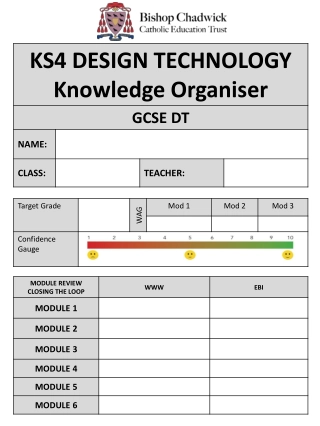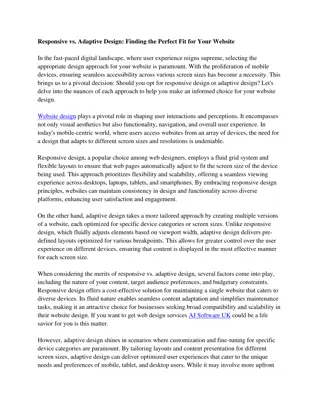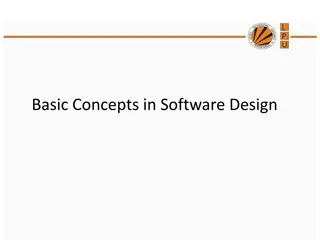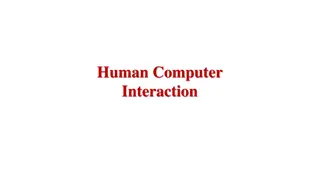
Effective UI Design Principles and Guidelines for User-Centric Interfaces
In UI design, prioritizing user experience over fancy aesthetics is crucial. Learn from experts like Jakob Nielsen and follow key principles such as system status visibility, user control, error prevention, and more to create interfaces that are easy to use and intuitive. Discover how to match design with real-world user expectations and ensure consistency with industry standards.
Download Presentation

Please find below an Image/Link to download the presentation.
The content on the website is provided AS IS for your information and personal use only. It may not be sold, licensed, or shared on other websites without obtaining consent from the author. If you encounter any issues during the download, it is possible that the publisher has removed the file from their server.
You are allowed to download the files provided on this website for personal or commercial use, subject to the condition that they are used lawfully. All files are the property of their respective owners.
The content on the website is provided AS IS for your information and personal use only. It may not be sold, licensed, or shared on other websites without obtaining consent from the author.
E N D
Presentation Transcript
UI Design IT S NOT JUST THE TECHNOLOGY
Clients are meant for users And users want/ need/ deserve an interface that is easy to use Fancy does NOT mean easy to use There are many examples (good and bad) to look at Most companies establish design guidelines for their brand There are some basic guidelines that are fairly consistent across most experts
Jakob Nielsen, Ph.D., is a User Advocate and principal of the Nielsen Norman Group which he co-founded with Dr. Donald A. Norman (former VP of research at Apple Computer). Nielsen s Heuristics #1: Visibility of system status #2: Match between system and the real world #3: User control and freedom #4: Consistency and standards #5: Error prevention #6: Recognition rather than recall #7: Flexibility and efficiency of use #8: Aesthetic and minimalist design #9: Help users recognize, diagnose, and recover from errors #10: Help and documentation 10 Usability Heuristics for User Interface Design (nngroup.com)
A little more detail (1) #1: Visibility of system status The design should always keep users informed about what is going on, through appropriate feedback within a reasonable amount of time. #2: Match between system and the real world The design should speak the users' language. Use words, phrases, and concepts familiar to the user, rather than internal jargon. Follow real-world conventions, making information appear in a natural and logical order.
A little more detail (2) #3: User control and freedom Users often perform actions by mistake. They need a clearly marked "emergency exit" to leave the unwanted action without having to go through an extended process. #4: Consistency and standards Users should not have to wonder whether different words, situations, or actions mean the same thing. Follow platform and industry conventions. #5: Error prevention Good error messages are important, but the best designs carefully prevent problems from occurring in the first place. Either eliminate error-prone conditions, or check for them and present users with a confirmation option before they commit to the action.
A little more detail (3) #6: Recognition rather than recall Minimize the user's memory load by making elements, actions, and options visible. The user should not have to remember information from one part of the interface to another. Information required to use the design (e.g. field labels or menu items) should be visible or easily retrievable when needed. #7: Flexibility and efficiency of use Shortcuts hidden from novice users may speed up the interaction for the expert user such that the design can cater to both inexperienced and experienced users. Allow users to tailor frequent actions.
Remove clutter Don t mix content Information when needed not in your face Clean/ clear organization and layout A little more detail (4) #8: Aesthetic and minimalist design Interfaces should not contain information which is irrelevant or rarely needed. Every extra unit of information in an interface competes with the relevant units of information and diminishes their relative visibility. #9: Help users recognize, diagnose, and recover from errors Error messages should be expressed in plain language (no error codes), precisely indicate the problem, and constructively suggest a solution. #10: Help and documentation It s best if the system doesn t need any additional explanation. However, it may be necessary to provide documentation to help users understand how to complete their tasks.
And more Gestalt Principle of Proximity Items placed in proximity are assumed to belong together - Group items that logically belong together - Don t put items that have different intent or, are parts of different actions, in the same group






















